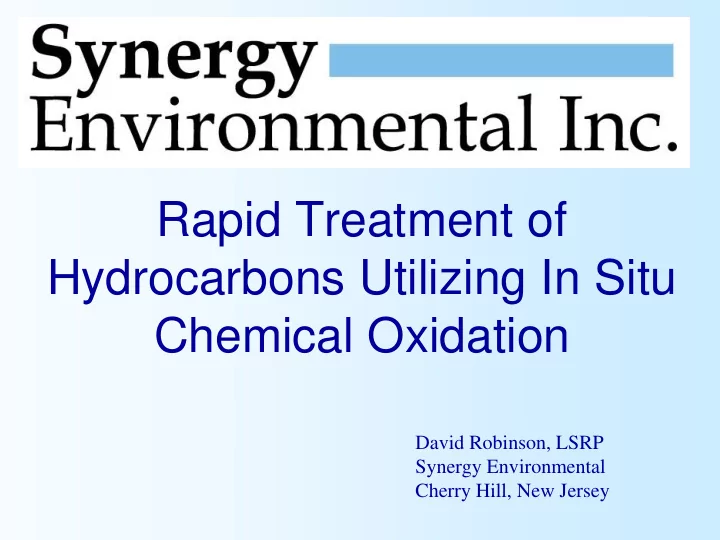

Rapid Treatment of Hydrocarbons Utilizing In Situ Chemical Oxidation David Robinson, LSRP Synergy Environmental Cherry Hill, New Jersey
Site Overview • Active retail petroleum site on NYS Thruway – Unleaded gas, diesel, kerosene • Not practical to shut down service station • 2006 – petroleum contamination discovered near dispensers – No groundwater quality investigation performed at that time – 2010 – 33 monitoring wells installed to determine groundwater quality
Geology • Regional Geology – Overburden soils consist of glacial till – Deeper strata bedrock • Site Geology – Silty/sand underlain by weathered shale – 5-10 ft drop in topography moving west to east across the site
Groundwater • Generally flows southeast following soil topography • Depth to groundwater – 3 feet below ground surface western portion of the property (near USTs) – 16 feet below ground surface eastern side of the property – Perched groundwater exists up-gradient of pump island
Perched GW
Analytical Results Soil contamination from Soil Groundwater • Compound Concentration max Concentration max 12 feet below grade to (mg/kg) (mg/L) 26 feet below grade ethylbenzene 77 12 n-butylbenzene 4.6 0.65 High concentrations of • isopropylbenzene 7.5 2.4 VOC gasoline constituents napthalene 29 3.5 n-propylbenzene 33 3.4 Groundwater above • toluene 230 36 NYSDEC cleanup 1,2,4-trimethylbenzene 210 20 levels extend 1,3,5-trimethylbenzene 60 7.7 throughout property total xylenes 430 61 GW source identified • MTBE not analyzed 0.2 downgradient of the pump island total SVOC <1.0 <1.0
Remedial Selection • Excavation – Active gas station and extent of contamination made excavation infeasible • Biodegradation/MNA – Based on soil/groundwater concentrations, NYSDEC would not considered • In situ chemical oxidation - ozone – Smallest treatment footprint – Effective – Short timeframe
Pilot Study • 3 sparge points installed – Upgradient, source area, down gradient – 2” id PVC risers with 3 feet of screen installed (installed to be used as monitoring wells later) – Subgrade conduit from well head to treatment trailer – ¼’ ozone compatible tubing snaked through conduit and sparge well – Packers used to seal wells and contain fugitive emission
Ozone System • Self contained trailer system used for ozone generation and sparge controls • Ozone generated utilizing 2 L/min air compressor, oxygen concentrator and 2.1 lb/day ozone generator • Compressed air added to stream post- ozone generator as makeup gas for desired flow rates
Pilot Test • Serial injection of ozone into each well SP-1 SP-2 SP-3 • Dissolved oxygen measured continuously at surrounding wells • Groundwater sampling performed post ozone treatment
Pilot Test • SP-1(Source Area) – Diffuser set at 25’ (GW @ 17 fbgs) – 6/L min flow 30 g/hr – 65 hours operation ~ 4.5 lbs O 3 • SP-2 (Down Gradient) – Diffuser set at 29’ (GW @ 16.5 fbgs) – 5/L min flow 27 g/hr – 145 hours operation ~ 8.6 lbs O 3
Pilot Test • SP-3 (Upgradient) – Diffuser set at 21’ (GW @ 8 ft bgs) – 4/L min flow 22 g/hr – 87 hours operation 4.2 lbs O 3 • Dissolved oxygen was sampled in surrounding wells to determine radii of influence
Dissolved Oxygen Results SP-1 SP-2 Distance From Distance From Initial DO Final DO Initial DO Final DO Well Sparge Point Well Sparge Point (mg/L) (mg/L) (mg/L) (mg/L) (feet) (feet) SP-1 0 0.99 15.6 MW-26 0.4 9.5 11.8 MW-22 12 1.06 1.87 MW-35 10 0.55 7.1 MW-35 19 0.46 1.56 EW-1 26 0.67 2.9 SP-2 30 1.53 10.17 No Influence Seen in Wells > 30 feet No Influence Seen in Wells > 40 feet SP-3 Distance From Initial DO Final DO Well Sparge Point (mg/L) (mg/L) (feet) MW-9 10 1.1 3.8 MW-34 16 0.8 2.2 No Influence Seen in Wells > 30 feet
Pilot Study Conclusion • The radius of influence for ozone is 20-30 feet depending on location • Concentrations of hydrocarbons in the source area (SP-1) did not degrade and showed a transient increase • Hydrocarbon concentrations upgradient/down gradient decreased • Ozone was delivered with enough pressure and flow to treat the large contamination area from a single trailer
Full Scale Treatment Approximately 5,000 lbs of VOCs in subsurface • Full scale treatment began in 2009 • System operated remotely through web-based • Remediation Operating System Equipment (ROSE) Groundwater monitoring performed quarterly • starting 2010 Results have shown consistent decrease in total • VOC concentrations Anticipate operating system until 2014 •
Treatment Trailer
Recommend
More recommend